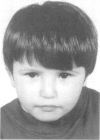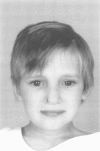Abstract
We report three cases of velocardiofacial syndrome (VCFS) with anal anomalies who have deletions of the 22q11 region and a further case where the proband has VCFS clinically and her father has an anal anomaly. It is important to consider VCFS in the differential diagnosis of children with anal anomalies and to look for other features of the syndrome, such as asymmetrical crying facies, submucous cleft of the palate, developmental delay, cardiac anomalies, and hypoparathyroidism.
Full text
PDF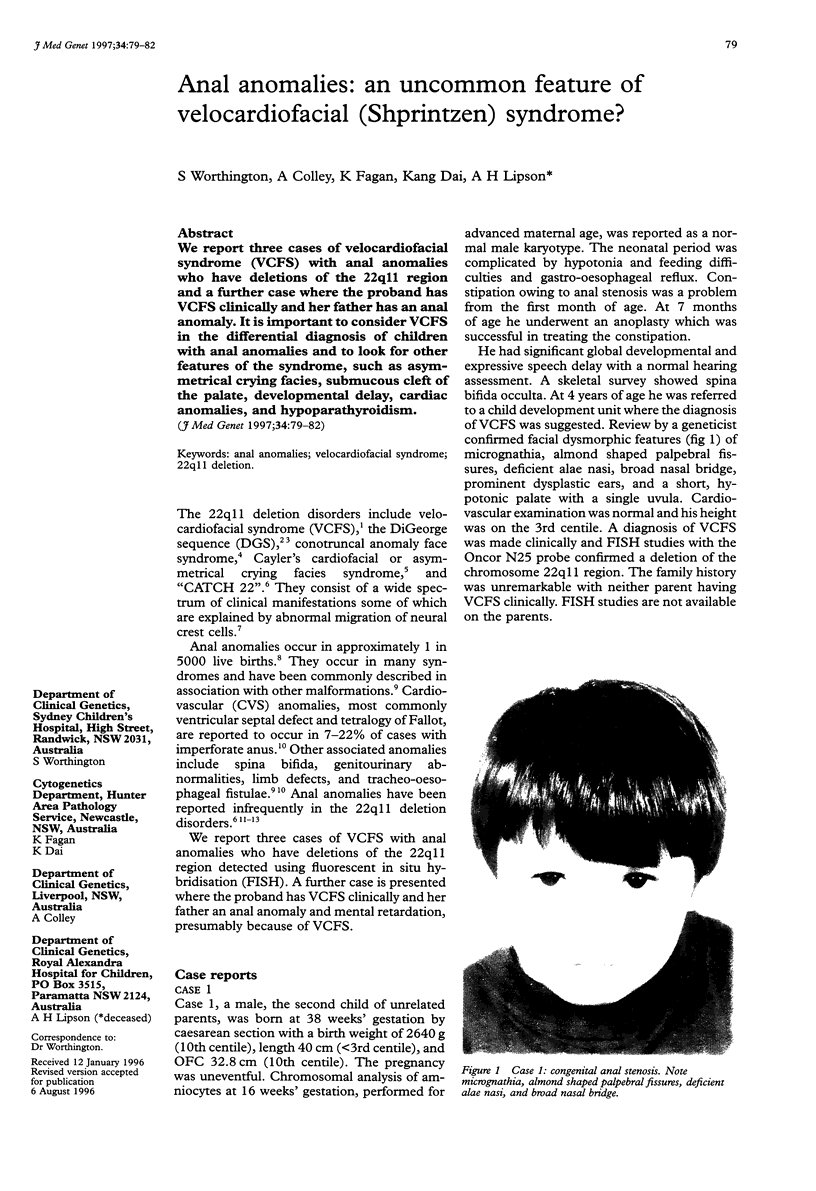
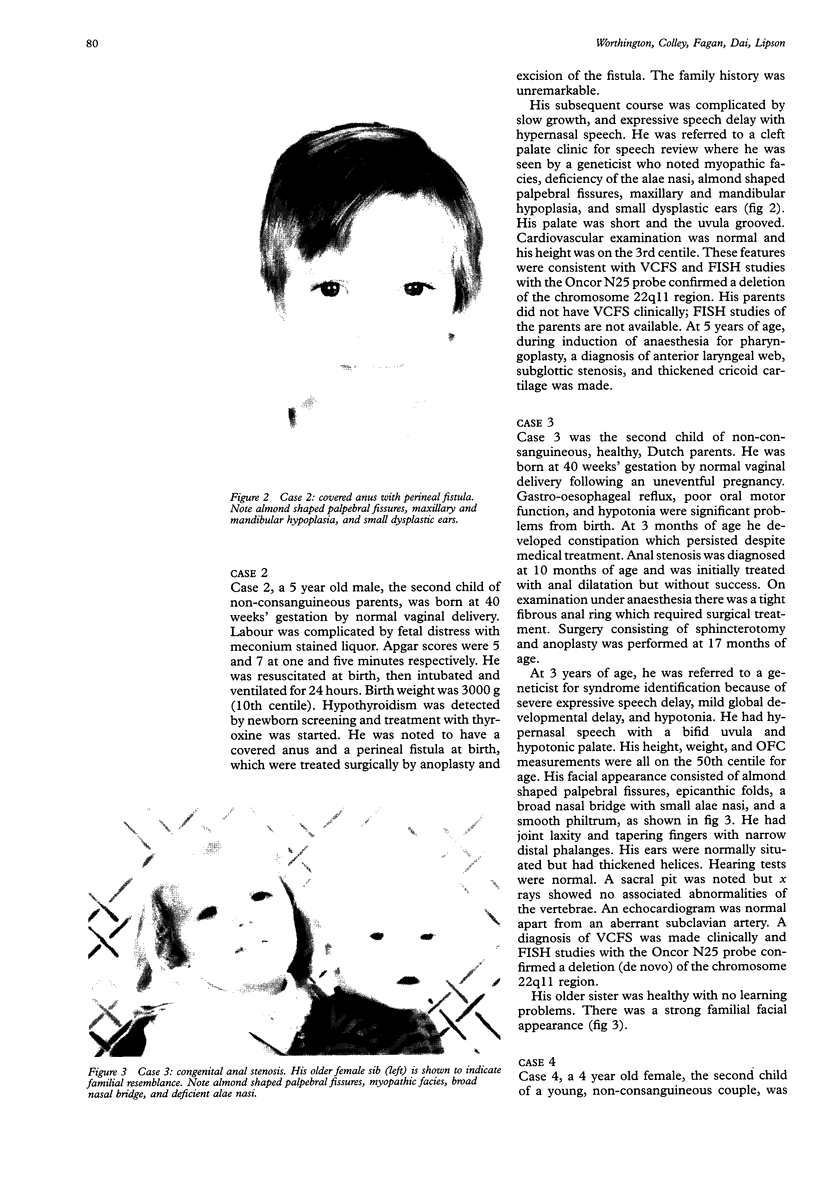
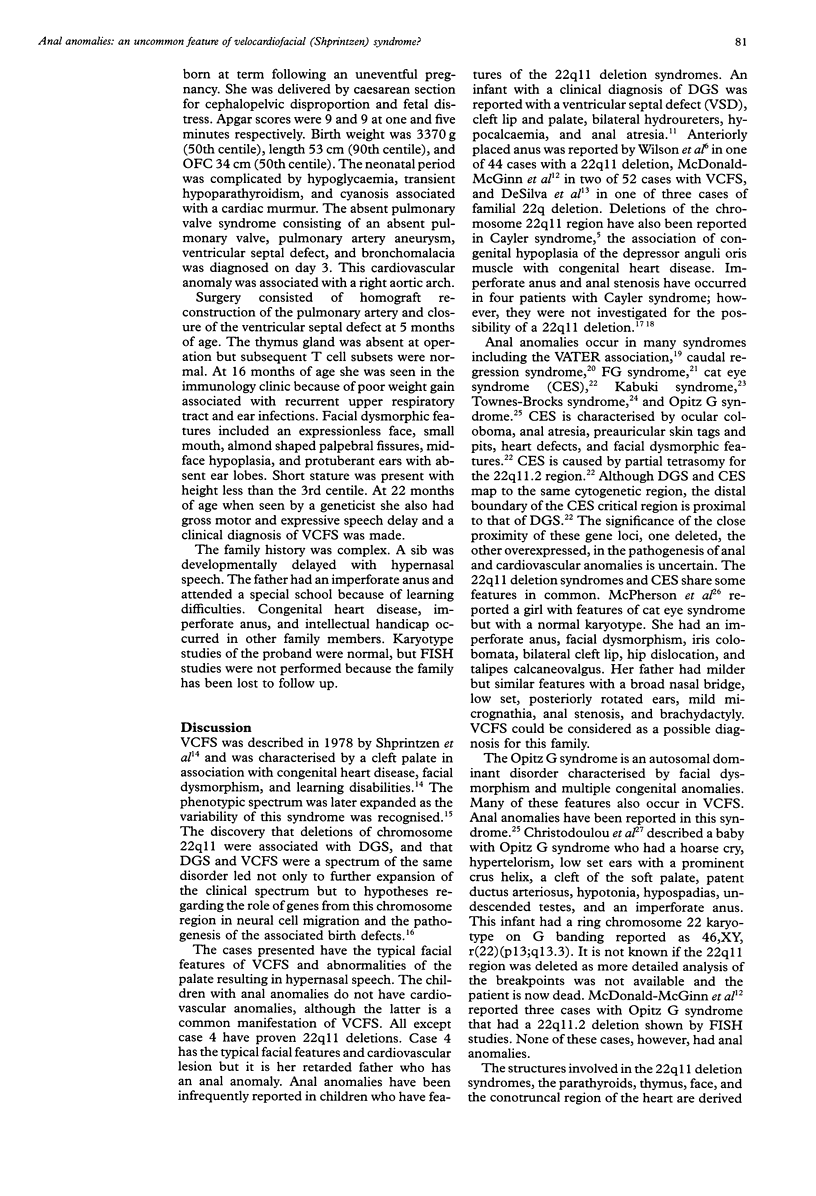
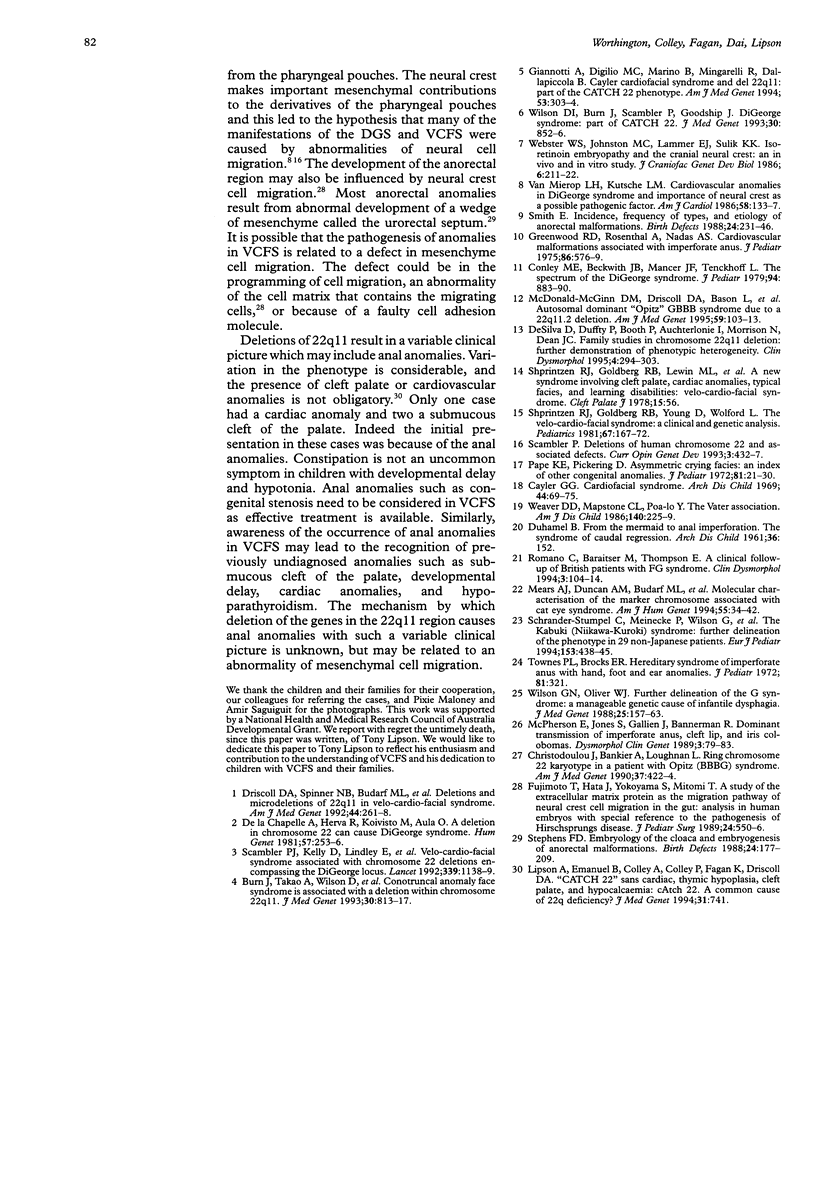
Images in this article
Selected References
These references are in PubMed. This may not be the complete list of references from this article.
- Cayler G. G. Cardiofacial syndrome. Congenital heart disease and facial weakness, a hitherto unrecognized association. Arch Dis Child. 1969 Feb;44(233):69–75. doi: 10.1136/adc.44.233.69. [DOI] [PMC free article] [PubMed] [Google Scholar]
- Christodoulou J., Bankier A., Loughnan P. Ring chromosome 22 karyotype in a patient with Opitz (BBBG) syndrome. Am J Med Genet. 1990 Nov;37(3):422–424. doi: 10.1002/ajmg.1320370324. [DOI] [PubMed] [Google Scholar]
- Conley M. E., Beckwith J. B., Mancer J. F., Tenckhoff L. The spectrum of the DiGeorge syndrome. J Pediatr. 1979 Jun;94(6):883–890. doi: 10.1016/s0022-3476(79)80207-3. [DOI] [PubMed] [Google Scholar]
- De Silva D., Duffty P., Booth P., Auchterlonie I., Morrison N., Dean J. C. Family studies in chromosome 22q11 deletion: further demonstration of phenotypic heterogeneity. Clin Dysmorphol. 1995 Oct;4(4):294–303. doi: 10.1097/00019605-199510000-00004. [DOI] [PubMed] [Google Scholar]
- Driscoll D. A., Salvin J., Sellinger B., Budarf M. L., McDonald-McGinn D. M., Zackai E. H., Emanuel B. S. Prevalence of 22q11 microdeletions in DiGeorge and velocardiofacial syndromes: implications for genetic counselling and prenatal diagnosis. J Med Genet. 1993 Oct;30(10):813–817. doi: 10.1136/jmg.30.10.813. [DOI] [PMC free article] [PubMed] [Google Scholar]
- Driscoll D. A., Spinner N. B., Budarf M. L., McDonald-McGinn D. M., Zackai E. H., Goldberg R. B., Shprintzen R. J., Saal H. M., Zonana J., Jones M. C. Deletions and microdeletions of 22q11.2 in velo-cardio-facial syndrome. Am J Med Genet. 1992 Sep 15;44(2):261–268. doi: 10.1002/ajmg.1320440237. [DOI] [PubMed] [Google Scholar]
- Fujimoto T., Hata J., Yokoyama S., Mitomi T. A study of the extracellular matrix protein as the migration pathway of neural crest cells in the gut: analysis in human embryos with special reference to the pathogenesis of Hirschsprung's disease. J Pediatr Surg. 1989 Jun;24(6):550–556. doi: 10.1016/s0022-3468(89)80504-4. [DOI] [PubMed] [Google Scholar]
- Giannotti A., Digilio M. C., Marino B., Mingarelli R., Dallapiccola B. Cayler cardiofacial syndrome and del 22q11: part of the CATCH22 phenotype. Am J Med Genet. 1994 Nov 15;53(3):303–304. doi: 10.1002/ajmg.1320530320. [DOI] [PubMed] [Google Scholar]
- Greenwood R. D., Rosenthal A., Nadas A. S. Cardiovascular malformations associated with imperforate anus. J Pediatr. 1975 Apr;86(4):576–579. doi: 10.1016/s0022-3476(75)80153-3. [DOI] [PubMed] [Google Scholar]
- Kaul R., Gao G. P., Aloya M., Balamurugan K., Petrosky A., Michals K., Matalon R. Canavan disease: mutations among Jewish and non-Jewish patients. Am J Hum Genet. 1994 Jul;55(1):34–41. [PMC free article] [PubMed] [Google Scholar]
- Lipson A., Emanuel B., Colley P., Fagan K., Driscoll D. A. "CATCH 22" sans cardiac anomaly, thymic hypoplasia, cleft palate, and hypocalcaemia: cAtch 22. A common result of 22q11 deficiency? J Med Genet. 1994 Sep;31(9):741–741. doi: 10.1136/jmg.31.9.741. [DOI] [PMC free article] [PubMed] [Google Scholar]
- McDonald-McGinn D. M., Driscoll D. A., Bason L., Christensen K., Lynch D., Sullivan K., Canning D., Zavod W., Quinn N., Rome J. Autosomal dominant "Opitz" GBBB syndrome due to a 22q11.2 deletion. Am J Med Genet. 1995 Oct 23;59(1):103–113. doi: 10.1002/ajmg.1320590122. [DOI] [PubMed] [Google Scholar]
- Pape K. E., Pickering D. Asymmetric crying facies: an index of other congenital anomalies. J Pediatr. 1972 Jul;81(1):21–30. doi: 10.1016/s0022-3476(72)80368-8. [DOI] [PubMed] [Google Scholar]
- Romano C., Baraitser M., Thompson E. A clinical follow-up of British patients with FG syndrome. Clin Dysmorphol. 1994 Apr;3(2):104–114. [PubMed] [Google Scholar]
- Scambler P. J. Deletions of human chromosome 22 and associated birth defects. Curr Opin Genet Dev. 1993 Jun;3(3):432–437. doi: 10.1016/0959-437x(93)90117-8. [DOI] [PubMed] [Google Scholar]
- Scambler P. J., Kelly D., Lindsay E., Williamson R., Goldberg R., Shprintzen R., Wilson D. I., Goodship J. A., Cross I. E., Burn J. Velo-cardio-facial syndrome associated with chromosome 22 deletions encompassing the DiGeorge locus. Lancet. 1992 May 9;339(8802):1138–1139. doi: 10.1016/0140-6736(92)90734-k. [DOI] [PubMed] [Google Scholar]
- Schrander-Stumpel C., Meinecke P., Wilson G., Gillessen-Kaesbach G., Tinschert S., König R., Philip N., Rizzo R., Schrander J., Pfeiffer L. The Kabuki (Niikawa-Kuroki) syndrome: further delineation of the phenotype in 29 non-Japanese patients. Eur J Pediatr. 1994 Jun;153(6):438–445. doi: 10.1007/BF01983409. [DOI] [PubMed] [Google Scholar]
- Shprintzen R. J., Goldberg R. B., Young D., Wolford L. The velo-cardio-facial syndrome: a clinical and genetic analysis. Pediatrics. 1981 Feb;67(2):167–172. [PubMed] [Google Scholar]
- Smith E. D. Incidence, frequency of types, and etiology of anorectal malformations. Birth Defects Orig Artic Ser. 1988;24(4):231–246. [PubMed] [Google Scholar]
- Stephens F. D. Embryology of the cloaca and embryogenesis of anorectal malformations. Birth Defects Orig Artic Ser. 1988;24(4):177–209. [PubMed] [Google Scholar]
- Townes P. L., Brocks E. R. Hereditary syndrome of imperforate anus with hand, foot, and ear anomalies. J Pediatr. 1972 Aug;81(2):321–326. doi: 10.1016/s0022-3476(72)80302-0. [DOI] [PubMed] [Google Scholar]
- Van Mierop L. H., Kutsche L. M. Cardiovascular anomalies in DiGeorge syndrome and importance of neural crest as a possible pathogenetic factor. Am J Cardiol. 1986 Jul 1;58(1):133–137. doi: 10.1016/0002-9149(86)90256-0. [DOI] [PubMed] [Google Scholar]
- Weaver D. D., Mapstone C. L., Yu P. L. The VATER association. Analysis of 46 patients. Am J Dis Child. 1986 Mar;140(3):225–229. doi: 10.1001/archpedi.1986.02140170051027. [DOI] [PubMed] [Google Scholar]
- Webster W. S., Johnston M. C., Lammer E. J., Sulik K. K. Isotretinoin embryopathy and the cranial neural crest: an in vivo and in vitro study. J Craniofac Genet Dev Biol. 1986;6(3):211–222. [PubMed] [Google Scholar]
- Wilson D. I., Burn J., Scambler P., Goodship J. DiGeorge syndrome: part of CATCH 22. J Med Genet. 1993 Oct;30(10):852–856. doi: 10.1136/jmg.30.10.852. [DOI] [PMC free article] [PubMed] [Google Scholar]
- Wilson G. N., Oliver W. J. Further delineation of the G syndrome: a manageable genetic cause of infantile dysphagia. J Med Genet. 1988 Mar;25(3):157–163. doi: 10.1136/jmg.25.3.157. [DOI] [PMC free article] [PubMed] [Google Scholar]
- de la Chapelle A., Herva R., Koivisto M., Aula P. A deletion in chromosome 22 can cause DiGeorge syndrome. Hum Genet. 1981;57(3):253–256. doi: 10.1007/BF00278938. [DOI] [PubMed] [Google Scholar]



